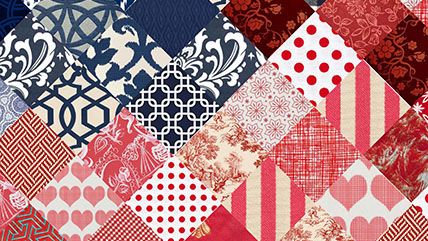Love Your Homemade Quilt? Thank Capitalism.
How industrialization keeps you warm at night

A patchwork quilt covering a bed in a country B&B or hanging on a museum wall evokes nostalgia for simpler times. Using simple shapes—triangles, squares, trapezoids, octagons—and the clever arrangement of color and pattern, the quilters of a bygone era created beauty and utility from what we wasteful moderns might simply discard. Symbolizing handicraft and thrift, quilts seem simultaneously old-fashioned and countercultural, an authentic alternative to impersonal industry. Not surprisingly, American quilts enjoyed their first renaissance in the 1920s, their second in the 1970s—both periods of rapid social change.
In reality, though, patchwork quilts wouldn't exist without trade, industrialization, and material abundance. They are the physical embodiment of what economist Deirdre McCloskey calls the Great Enrichment: a bourgeois art par excellence.
Patching is as old as clothes, and sewing fibrous batting between two sheets for warmth is ancient. Patchwork quilts are much more recent. The earliest date back to the late 17th century, when vibrant cotton prints from India were all the rage among the European gentry. More than a century passed before ordinary people began sleeping under geometrical patterns created from small, colorful, precisely cut shapes. Patchwork quilts became common only after textile production surged and prices dropped thanks to the mechanical innovations we now call the Industrial Revolution.
By the early 19th century, cheap factory-made fabrics spread the luxury of tailored clothes beyond the rich and their liveried servants. Traditional peasant clothing is made up of rectangles that preserve as much cloth as possible for eventual reuse. Skirts are gathered rather than fitted with darts and seams; shirts and blouses hang away from the body; sleeves are billowy. These shapes reflect material constraints, not stylish silhouettes. As the price of fabric dropped, ordinary people's wardrobes grew and homemade clothing became more fashionable and fitted.
Cutting sleeves or bodices in curved pieces to fit the body inevitably produces leftover bits of fabric. These awkward leavings could go in the trash, or to the ragman. But with a snip here and there, they become the triangles or squares of a patchwork pattern.
As quilt-making grew in popularity, it generated new demand for fabric scraps. Women stored and swapped leftover bits. In an 1811 letter, Jane Austen nagged her sister to send her promised supplies: "Have you remembered to collect peices [sic] for the Patchwork?—We are now at a standstill." Dressmakers and fabric mills sold scraps and remnants by the pound, usually to people making quilts to sell. "Some communities and rural regions became renowned for their quilts, as women turned long winters into essential income," writes the economic historian Beverly Lemire.
The time to laboriously piece together patchwork patterns was itself a gift of industrial production. Throughout history, women had spent their days spinning thread. Supplying a single hand-weaver could take eight, 10, even 20 spinners, depending on the type of fabric. The new spinning mills made that work unnecessary—the robots are taking our jobs!—and women found more artistic and sociable uses for their household industry. "As spinning wheels were discarded, quilting assumed greater importance," Lemire writes.
The connection between quilts and newfound abundance didn't end there. Industrial production made scissors and shears affordable and slashed the cost of needles and pins. Synthetic dyes introduced a profusion of bright colors, while copper-plate printing applied them in ever-changing fashionable patterns. Even the cotton thread for all those neat hand stitches required significant innovation. Before the 19th century, sewing thread was expensive silk or linen.
"Cotton sewing thread is the fine, hard-finish product of plied yarns twisted tightly in the plying process against the original direction of spinning," writes historian of technology Rachel Maines. "No process existed for making this product before the first decade of the 19th century; only the soft and relatively uneven yarns used for weaving and the untwisted floss employed in embroidery were available. Thread before 1810 was thus mainly a handmade and costly component of quilt-making."
By the late 19th century, quilters were using sewing machines to speed up their work, if only when adding borders, often from store-bought fabric. Knowing that her mid-20th century readers were unlikely to sew by hand, Rose Wilder Lane defended mechanized quilt-making in her 1963 book on American needlework: "I was a pioneer child; I know how pioneer women welcomed the marvelous machine, incredulously admiring its swiftness and its perfect stitching, and thanked God for easing women's work. Whether your tool is a needle or tamed electricity, your patchwork is your own; you can express yourself in pattern and colors and way of working."
Today quilters sew on computerized machines that offer scores of different stitches and cost a mere fraction of what the pioneers paid, whether measured in real dollars or hourly wages. These hobbyists generally buy their cloth new, keeping fabric stores alive now that most apparel is cheaper to buy than to make. Quilters can even purchase bundles of precut squares known as "fat quarters" and design whole new patterns for on-demand digital printing at Spoonflower.com.
If you think of patchwork quilts as remnants of a tranquil age before mass-market production, all this commerce and technology will seem like cheating. But it's true to the craft's actual heritage.
Patchwork quilts were never necessities. They were practical pleasures—self-expression enabled by mass production, handwork made possible by technological advances. They are as modern as their crisp colors and precise geometries. Do-it-yourself crafts can only exist, after all, when you no longer have to do everything yourself.
This article originally appeared in print under the headline "Love Your Homemade Quilt? Thank Capitalism.."


Show Comments (181)